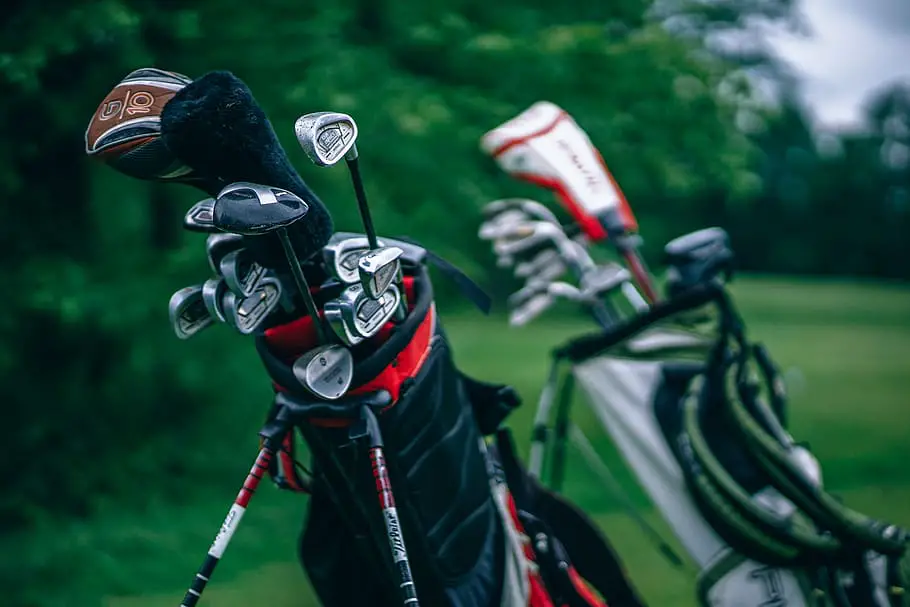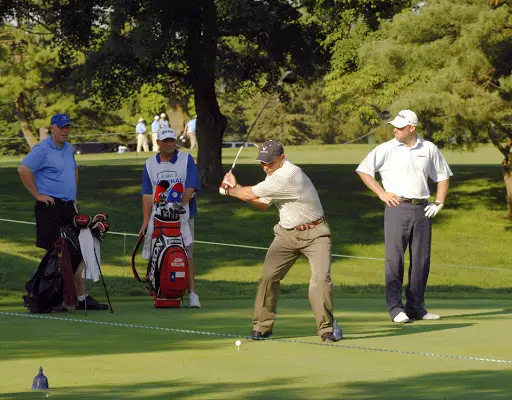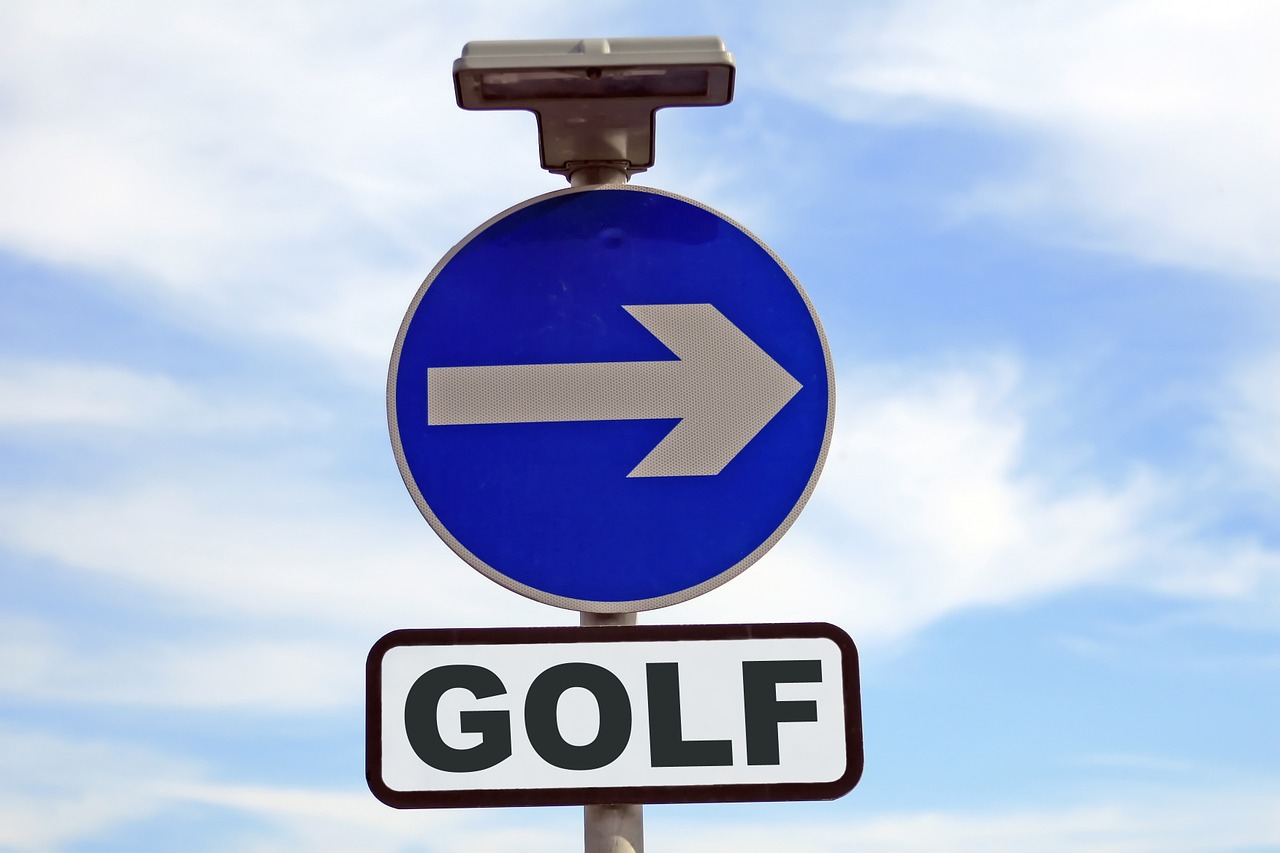For players new to the sport, there are many things to get familiar with in golf including clubs, tees, balls, clothing, and additional gear and gadgets – not to mention the terms and phrases that come along with playing!
In this guide we’ll walk through all the golf terms and phrases you’ll need to know, and when you may need to use them. Having an understanding of these terms will help you better understand the game and make better conversation both on and off the course.
Common Golf Scoring Terms

Par: refers to the number of expected strokes a golfer would take to complete a hole.
Birdie: when a golfer completes a hole one stroke under par.
Eagle: when a golfer completes a hole two strokes under par.
Double Eagle: when a golfer completes a hole three strokes under par.
Condor: when a golfer completes a hole four strokes under par (also called a Triple Eagle).
Ace: a hole-in-one (very rare, and definitely a cause for celebration)!
Bogey: when a golfer completes a hole one stroke over par.
Double Bogey: when a golfer completes a hole two strokes over par.
Triple Bogey: when a golfer completes a hole three strokes over par.
Gross Score: A total number of strokes a golfer takes during a round of golf, plus any penalty strokes.
Net Score: A player’s Gross Score minus their Handicap.
Handicap: A number representing a golfer’s general playing ability.
Unusual and Funny Golf Terms

Army Golf: used when someone putts back and forth past the hole, overhitting their shot again and again.
Afraid of the Dark: used to describe when a golfer’s ball seems to avoid going in the hole.
Barkie: used when a golfer hits a tree and still makes par on the hole.
Backhander: when a golfer putts in the ball using the opposite side of their putter.
Breakfast Ball: typically this applies on the first hole on a morning round of golf, and is sometimes used to offer a player a “free hit” on the first tee. This isn’t an official rule, so check with your other players before claiming it!
Cabbage: if you hit your ball into some dense foliage, you’re “in the cabbage”.
Coast-to-Coast Flight: when a golfer hits their ball from one bunker to another on the other side of the putting green.
Chili-Dip: if you take a large chunk (divot) in the ground with your chip swing, you’ve made a chili-dip!
Chicken Stick: you’ve got a club in your bag that you’ve chosen because it’s the safest choice for the shot (in other words, you didn’t take any risks when choosing your club).
Chippie: a shot taken from around the green.
Chunk: the chunk of ground a golfer might take out of the course when making a swing.
Cup: the hole in which the ball goes into – it’s 4 inches deep by 4.5 inches wide.
Dawn Patrol: used to describe golfers who get out on the course very early in the morning.
DNF and DFL: DNF is a universal sports team that means “Did Not Finish.” DFL is intended to mean Dead F—-ing Last!
Dammit: The most common curse on the golf course.
Dance Floor: Another term for the putting green (where a lot of the action happens on the course – get it?)
Double Cross: the direction a golfer’s ball goes after making contact with the club (used when a ball goes the complete opposite way than what the golfer intended).
Duck Hook: a ball that has been hooked poorly.
Duff: a terrible shot, also called a Shank, Flub, or Dub.
Flusher: when a ball circles around the hole before dropping in.
Foot Wedge: kicking your ball into a better place to continue playing the hole.
Frenchie: when a ball is hit into a tree and bounces back on to the fairway.
Fried Egg: a golf ball buried in the sand bunker.
Gardening: a player placing their chunk or divot back on the course, fixing it after a swing.
Gimme: when a putt is so close to being made that it’s assumed the putt would be completed, giving the player the shot.
Hacker: a poor golfer who either becomes frustrated and quits, or someone who has very little or no golf etiquette.
Hosel Rocket: an aggressively shanked ball. This usually happens when a golfer hits the ball with the shaft of the club before the club head.
In the Leather: another term for Gimme.
James Joyce: refers to when a putt has a very challenging line to the hole.
Knockdown: a shot made intentionally low to the ground to avoid the winds higher up in the air (used generally when playing on windy days).
Mud Ball: when your golf ball is covered in mud!
Mulligan: a “do-over” shot taken without counting the stroke toward a player’s score, typically used in casual play.
Platypus: used when a golfer makes par after hitting the ball out of bounds.
Poley: a putt made that is longer than the flagstick’s length.
Rush Limbaugh: used when a ball sits extremely far to the right on the course!
Sandy (or Sandie): when a golfer makes par after hitting the ball in a sand bunker.
Sharkie: when a golfer makes par after hitting the ball in the water.
Shrimp: a strong hook resembling the shape of a shrimp.
Snowman: Used when a golfer scores 8 on a hole (the 8 resembles a snowman’s shape).
Stony: a shot that lands close to the flagstick.
Ted Kennedy: Like the Rush Limbaugh, except that the ball is extremely far left (see what they did there?)
That Dog Will Hunt: used after a great tee shot.
Three Jack: a golfer takes three putts to put the ball in the hole.
Turkey: used when a golfer gets three consecutive birdies during a single round of golf.
USGA: Acronym for “Ugly Shot, Go Again”.
Waggle: the pre-shot routine where a golfer adjusts their body, the club, or takes a practice swing at the ball.
Whiff: a shot where the golfer fails to make contact with the ball.
Wormburner: a ball that keeps rolling for a long distance.
Yips: Used to describe the nerves or jitters a golfer gets when about to make an important shot or putt.
Zinger: A ball that causes a vibration in the club, usually when hit high and hard close to the leading edge of the club.
Golf Course Terms

Apron: the shorter grass right in front of the green.
Front Nine: the first nine holes of golf on an 18-hole golf course.
Back Nine: the second nine holes of golf on an 18-hole golf course.
Ball Washer: A device for cleaning golf balls, usually located near the tee.
Beach: a sand bunker.
Blind: A shot where the golfer cannot see where the ball will land.
Caddie: A person who carries a player’s bag and clubs and provides advice to the golfer.
Cart Path: A path running next to and connecting the holes on a golf course intended for golf carts to drive on (it should be noted that on some courses it’s okay to drive a cart off the path, but never on a green!).
Casual Water: Water on the golf course that’s not part of a penalty, typically found after heavy rains or light flooding. Generally, it’s accepted that the player can move the ball from casual water without penalty.
Clubhouse: A building on a course that offers golfers changing rooms, events, offices, and a restaurant or bar. Sometimes called the Nineteenth Hole and usually situated near the first and final holes of a course.
Cup: slang for the hole on a course.
Deep: a flagstick or hole that’s near the back of the green.
Divot: the chunk of grass or dirt removed during a player’s stroke.
Dog leg: a golf hole that is crooked rather than straight. Dogleg is used to refer to a hole that bends to the left, while Dogleg right is the opposite.
Dormie House: A building providing overnight accommodations at a golf club,
Fairway: the short-mowed center portion of a golf hole between the teeing area and the green,
First tee: where a round of golf begins,
Flag & Flag Stick: the flag is a piece fabric attached to a flagstick to show golfers where the hole is located. The flagstick is a pole placed in the hole on the green, and can be removed when putts are being made.
Forward tee: the teeing area closest to the green.
Grain: the direction the grass is growing on the green. The ball rolls faster with the grain, and slower against the grain.
Green fee: the cost of playing a round of golf on a course. Also can be called a greens fee.
Ground Under Repair: any part of a golf course unfit for play that’s undergoing maintenance or could be damaged.
Halfway House: a small building or stand usually located between the 9th and 10th holes that provides refreshments and snacks for golfers.
Hard Pan: Bare and hard ground conditions that have very little or no grass.
Home Course: the golf course where a player houses their handicap.
Lip: the edge of the hole.
Loose Impediments: natural occurrences on the course that aren’t stuck in the ground or growing in the ground, such as rocks, twigs, and leaves.
Movable Obstruction: Anything artificial on the golf course that can be moved with typical effort, such as a tee, pencil, litter, or a water bottle.
Nineteenth Hole: a golf course’s lounge or restaurant.
Out of Bounds: the area where play is not allowed outside of the course, typically marked by white stakes.
Pace of Play: how much time it takes to complete either a golf stroke, an individual hole, or a round of golf.
Pin: the flagstick, also called “the stick”.
Playing through: when a group of golfers allows another group of golfers to pass through and end up ahead of their group.
Ranger: a member of a golf course’s staff who provides player assistance on the course. This person is also responsible for keeping the pace of play on the course.
Rough: the long grass on the borders of the fairway.
Sand Bunker: a bunker filled with sand (typically 4 to 6 inches in depth) on a golf course.
Starter: think of this as a Ranger for the first tee – they keep the proper amount of time between groups of players starting off at the first tee and provide golfers with any special information they might need.
Tee Box: the area where a golf ball is first struck on a hole, also referred to as the “teeing area” or “teeing ground”.
Temporary Green: Used when a hole’s permanent green is under repair.
The Tips: The teeing area farthest from the green (usually identified by blue, gold, or black tee markers). These are also called “back tees” or “championship tees”.
Twilight Rate: A discounted green fee offered during the evening.
Golf Equipment Terms

Ball: The golf ball hit by golfers on a hole or course. There are many types of golf balls with different construction types and materials that affect the ball’s performance.
Iron: the metal clubs in a golfer’s bag, numbered one to nine – the lower the number on the iron, the longer distance a ball will travel when hit.
Grip: the part of the golf club the player grips with their hands.
Launch Monitor: a device that uses radar, image capture, or infrared technology to measure data on a golf ball when hit. Can be used as part of a golf simulator setup.
Push or pull cart: A wheeled device that carries a golf bag, usually used by golfers who would rather walk the course instead of using a cart. Also can be called a golf trolley.
Putter: a flatter-edged golf club intended to make the ball roll smoothly along the green.
Rangefinder: a device golfers use to measure the distance to the hole, typically using lasers.
Rickshaw: a Push or Pull cart with two large tires.
Sand Wedge: a heavily-angled club used for hitting the ball out of a sand bunker.
Sticks: Slang for Golf Clubs.
Tee: a wooden or plastic peg which a golfer places in the ground and hits their ball from at the start of each hole.
Wood: these are clubs used to hit the ball the farthest and are usually used on the first shot. Most modern day woods are made out of metal but used to be made from wood, hence their name.
Types of Golf Games

Alternate Shot: A format of golf competition where two golfers play as partners, playing one golf ball and alternating strokes with each other.
Best Ball: A play format usually used in tournaments in which the team score for each hole is a player’s best score of at least one in a foursome of players. This is often mistaken for Scramble.
Bingo, Bango, Bongo: A betting game where three points are available on each hole: one for the first person to land a ball on the green (Bingo), another for the ball closest to the hole once all balls are on the green (Bango), and another for the longest putt completed (Bongo).
Greenies: A game where money goes to the player whose ball is closest to the hole and on the green on a Par 3 (as long as the player scores par or better).
Match Play: A golfing format where the goal is to win individual holes rather than totaling all strokes played during the round of holes.
Modified Scramble: Also called a Texas Scramble or Shamble, a style of play where the players select the best shot off the tee, move all player’s balls to that spot, and then resume individual stroke play for the rest of the hole.
Nassau: A golf betting game that contains three bets: the best match play score on the front nine holes, the best match play score on the back nine holes, and the best score on the entire 18 holes.
Scramble: Each player in a foursome hits the ball, then the group selects the best shot. The process is repeated until the hole is completed. This is the most popular format of most charity golf tournaments.
Shamble: See Modified Scramble.Skins: Golf betting game where the player who posts the lowest score on an individual hole wins a skin, or a specific bet amount (such as $5 per skin, or $10 per skin).

